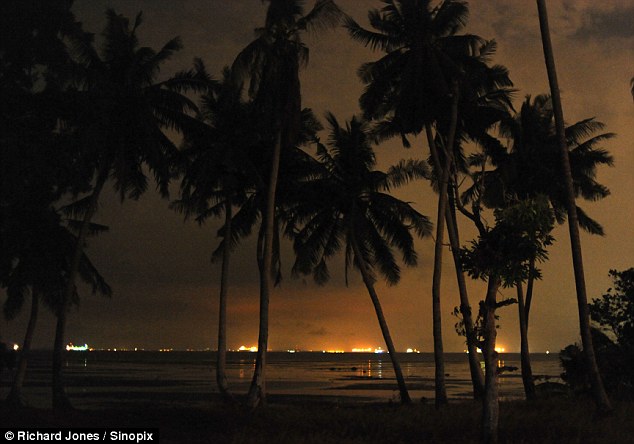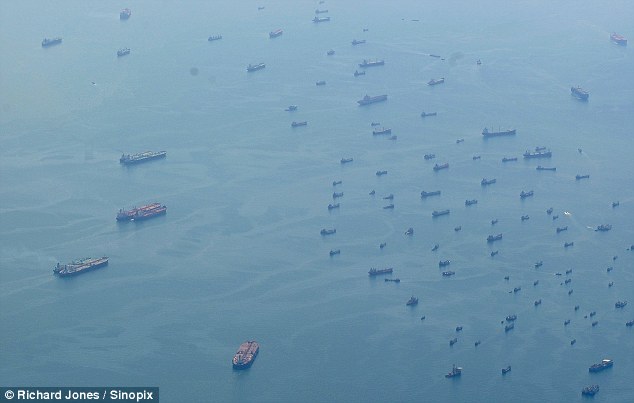From the Daily Mail.
The biggest and most secretive gathering of ships in maritime history lies at anchor east of Singapore. Never before photographed, it is bigger than the U.S. and British navies combined but has no crew, no cargo and no destination – and is why your Christmas stocking may be on the light side this year.
It is so far off the beaten track that nobody ever really comes close, which is why these ships are here. The world’s ship owners and government economists would prefer you not to see this symbol of the depths of the plague still crippling the world’s economies. So they have been quietly retired to this equatorial backwater, to be maintained only by a handful of bored sailors. The skeleton crews are left alone to fend off the ever-present threats of piracy and collisions in the congested waters as the hulls gather rust and seaweed at what should be their busiest time of year.



And Obama has just lit the fuze for a trade war with China just to protect a few thousand United Steelworkers who have priced themselves out of a job. That will expand the fleet even more. Might be a good time to invest in a ship scrapyard. Oh, wait those are all in India and China now.
At least on my computer, there is a huge white space..several pages in length..between the text and the first photo.
That is a great article.
Did you ever see that article a few years back, I think it was in the Atlantic, of how they beach the ships in India and Bangladesh and armies of individuals, armed with blowtorches, cut the ships to pieces by hand? It was amazing.
At least on my computer, there is a huge white space..several pages in length..between the text and the first photo.
It’s a flaw in the blog layout. I’m probably going to change the layout for this reason.
That last picture is taken off Sentosa island, which is an island to the south of the city. I saw this fleet when I was there last year, but had assumed ti was just the queue for getting into the port.
Jonathan: No problem in Firefox 3.5.
David Foster: FF is free. Switch or upgrade.
Carl – that article was amazing, it may have been in Monocle. for those who haven’t read about it, they have literal cities that have sprung up around the industry of scrapping ships and they do it by hand in India with gas axes. People die doing it all the time.
Ask and you shall receive: The Atlantic’s own web page says it’s unavailable due to author’s request, but keeping with the nautical theme there is a pirated version available here–for now.
And Carl, I’m not sure that cutting torches qualify for “by hand”–my hands, at any rate, are not capable of cutting steel, or even the softest cast iron, for that matter. But of course your real point is clear, that no great big machines are involved. :-)
Lex,
My Brother works in a major container shipping firm that just laid off a 1,000 people. He told me back in December 2008 that he was sending cargo ships back to China with only 42% of capacity filled.
In other words, 58% empty.
When I moved to Dallas in July 2008, Dallas Texas Truck/Rail container “port” was at less than 70% capacity and falling. It was near empty in March 2009 and the city of Dallas has pulled funding for the facility.
Since most of the cargo sent back to China from the USA is metal and plastic scrap of various sorts used as feed stock to make consumer goods, we are starting to see the return feed back. Or more accurately, it’s lack at west coast container ports per the LA Times article below.
http://www.latimes.com/business/la-fi-tradecrash2-2009mar02,0,807159.story?track=rss
GLOBAL TRADE
Port cargo levels are sinking fast
Robert Durell / Los Angeles Times
The WSJ reported about a similar issue with rail cars here in America. More of the same from the WSJ link:
http://online.wsj.com/article/SB123535033769344811.html
The picture the WSJ article showed was of car transport rail cars. The numbers described in the article tell me that automobile rail shipments effectively ceased in the USA for several weeks in Feb-April 2009.
All the signs of a busted economic bubble were in the rail transportation system when I travelled by car from Dallas to Denver in March & April 2009, took a trip to Houston and then visited my folks in San Antonio. In three weeks I traveled by car round trip from Dallas to Houston, Dallas to San Antonio and from Dallas to Denver with my wife and child.
I took I-45 to Hwy 14 to College Station and then down Highway 6 and Highway 36 to the Houston Area and came back up I-45 to Dallas.
I took I-35E south to San Antonio from Dallas and back up it.
In our trip to Denver, we went went up I-35 to Kansas and then via I-70 to Denver. Then our trip back to Dallas was down through Colorado, through New Mexico along the old Santa Fe trail, to Amarillo, through North Texas catch I-35E going south to Dallas.
Every rail siding, and our interstates paralleled rail lines about 80% on routes we took, was just full of rail car rolling stock. I mean every kind I of rail car I have ever seen plus a few I had not. Major rail switching yards in Trinidad New Mexico and Lake Belton area in Texas were over 80% filled with rail cars.
The container rail car traffic was notable by it’s lack of Chinese branded container boxes. Hanjin, Cosco, and several other asian container boxes were down to one or two boxes per train vice the dozens I normally see on trains from the port of Houston.
Heck, I saw a single train of pure American military containers and vehicles in North Texas that had more boxes than the total number of Chinese and Asian branded containers on my whole trip.
I’d bet that US rail traffic was down a minimum of 20% and Asian container volumes are down as much as 70% based on what I saw in my days of driving.
There is so much slack in cargo container box shipping that a huge supply of intermediate production goods can be in the world supply chain, feeding what manufacturing production is left, before new orders of goods are placed.
The bottom line is that so many shippers are over leveraged, in expansion plans that won’t ever make money, that many just won’t survive:
See:
http://www.businessweek.com/print/globalbiz/content/aug2009/gb20090811_320246.htm
Europe August 11, 2009, 12:32PM EST text size: TT
Shipping Industry Fights for Survival
A brutal downturn in global trade has left shippers with idle capacity, billions in losses, and even facing potential bankruptcy
By Alexander Jung, Thomas Schulz and Wieland Wagner
“Although the shipping industry has always gone through cycles, shipping companies now believe that things have changed drastically, and for the worse. “There was never a shortage of cargo in the past,” says Kranich. But that’s no longer the case today. Because of declines in consumption in the West and production in the East, the global container fleet’s enormous cargo capacity can no longer be filled. The resulting sharp decline in prices means that almost all shipping companies are generating substantial losses.
and
There is little evidence of a recovery in the port of Charleston, South Carolina. There is only a single ship, the MSC Prague, docked at the wharfs in one the biggest ports in the United States. Only last year, brand-new, giant cranes were installed at the Charleston terminal. Many of them are now idle, partly because orders are sharply down among German machine-building companies.
Forty-five percent of US imports of German goods pass through Charleston. Containers owned by German shippers like Hapag-Lloyd and Hamburg-Süd are stacked high in the harbor. BMWs, fresh off the assembly lines, stand in endless rows at the wharf. They include SUVs produced at the company’s nearby plant, bound for Europe, as well as 3 series and 5 series cars intended for the US market.”
Bleh!
That should have read to “In-Cog-Nito”
My bad.
In-Cog-Nito,
Did you catch this passage in your linked post:
South Korean shipyard Hanjin Heavy Industries last week said it had been forced to put up for sale three container ships ordered at a cost of £60 million ($100 million) by the Iranian state shipping line after the Iranians said they could not pay the bill.
We may well see the Iranian and North Korea states go down in the current recession for reasons unrelated to their nukes.
The problem is that the South Koreans may well be going with them.
Thank you Trent. Very informative observations and references. It’ll take me a while to read through it, but looks very interesting.
Deleveraging is, and will be, very painful. The above-historical-average quantity of products the ships shipped were, of coursed, fueled and financed in part with home equity loans. That debt-fueled spending isn’t coming back any time soon. So, as the shippers have built the wrong capacity, they need to either voluntarily decrease or involuntarily liquidate that capacity. It’s healthy and normal in terms of economics. The human cost will be high, however, since people, likewise, adapted to the wrong capacity of money and spending.